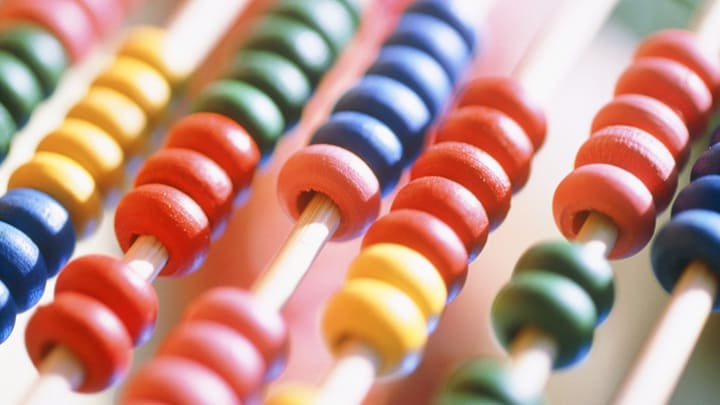Today is a big day for lovers of the number 12, and no one loves 12s more than the members of the Dozenal Society. The Dozenal Society advocates for ditching the base-10 system we use for counting in favor of a base-12 system. Because 12 is cleanly divisible by more factors than 10 is (1, 2, 3, 4, 6 and 12 vs. 1, 2, 5 and 10), such a system would neaten up our mathematical lives in various ways. But a dozenal system would require us to change our number words so that, for example, what we know as 20 would mean 24 (2x12), 30 would mean 36, and so on. Does that blow your mind a little too much? Well there are all sorts of weird things that languages can do with number words. Here are 12 of them.
1. Oksapmin, base-27 body part counting
The Oksapmin people of New Guinea have a base-27 counting system. The words for numbers are the words for the 27 body parts they use for counting, starting at the thumb of one hand, going up to the nose, then down the other side of the body to the pinky of the other hand, as shown in the drawing. 'One' is tip^na (thumb), 6 is dopa (wrist), 12 is nata (ear), 16 is tan-nata (ear on the other side), all the way to 27, or tan-h^th^ta (pinky on the other side).
2. Tzotzil, base-20 body part counting
Tzotzil, a Mayan language spoken in Mexico, has a vigesimal, or base-20, counting system. Why might a base-20 system come about? Fingers and toes! For numbers above 20, you refer to the digits of the next full man (vinik). Twenty-one is jun scha'vinik (first digit of the second man), 42 is chib yoxvinik (second digit of the third man), and 70 is lajuneb chanvinik (tenth digit of the fourth man).
3. Yoruba, base-20 with subtraction
Yoruba, a Niger-Congo language spoken in West Africa, also has a base-20 system, but it is complicated by the fact that for each 10 numbers you advance, you add for the digits 1-4 and subtract for the digits 5-9. Fourteen (??rinlá) is 10+4 while 17 (eétàdílógún) is 20-3. So, combining base-20 and subtraction means 77 is m?tadil?g?rin, or (20x4)-3.
4. Traditional Welsh, base-20 with a pivot at 15
Though modern Welsh uses base-10 numbers, the traditional system was base-20, with the added twist of using 15 as a reference point. Once you advance by 15 (pymtheg) you add units to that number. So 16 is un ar bymtheg (one on 15), 36 is un ar bymtheg ar hugain (one on 15 on 20), and so on.
5. Alamblak, numbers built from 1, 2, 5, and 20
In Alamblak, a language of Papua New Guinea, there are only words for 1, 2, 5, and 20, and all other numbers are built out of those. So 14 is (5x2)+2+2, or tir hosfi hosfihosf, and 59 is (20x2)+(5x(2+1))+(2+2) or yima hosfi tir hosfirpati hosfihosf.
6. Ndom, base-6
Ndom, another language of Papua New Guinea, has a base-6, or senary number system. It has basic words for 6, 18, and 36 (mer, tondor, nif) and other numbers are built with reference to those. The number 25 is tondor abo mer abo sas (18+6+1), and 90 is nif thef abo tondor ((36x2)+18).
7. Huli, base-15
The Papua New Guinea language Huli uses a base-15, or pentadecimal system. Numbers which are multiples of 15 are simple words. Where the English word for 225 is quite long, the Huli word is ngui ngui, or 15 15. However 80 in Huli is ngui dau, ngui waragane-gonaga duria ((15x5)+the 5th member of the 6th 15).
8. Bukiyip, base-3 and base-4 together
In Bukiyip, another Papua New Guinea language also known as Mountain Arapesh, there are two counting systems, and which one you use depends on what you are counting. Coconuts, days, and fish are counted in base-3. Betel nuts, bananas, and shields are counted in base-4. The word anauwip means 6 in the base-3 system and 24 in the base-4 system!
9. Supyire, numbers built from 1, 5, 10, 20, 80, and 400
Supyire, a Niger-Congo language spoken in Mali has basic number words for 1, 5, 10, 20, 80 and 400, and builds the rest of the numbers from those. The word for 600 is kàmpwòò ná ?kwuu shuuní ná bééshùùnnì, or 400+(80x2)+(20x2)
10. Danish, forms some multiples of ten with fractions
Danish counting looks pretty familiar until you get to 50, and then things get weird with fractions. The number 50 is halvtreds, a shortening of halv tred sinds tyve ("half third times 20" or 2½x20). The number 70 is 3½x20, and 90 is 4½x20.
11. French, mix of base-10 and base-20
French uses base-10 counting until 70, at which point it transitions to a mixture with base-20. The number 70 is soixante-dix (60+10), 80 is quatre-vingts (4x20), and 90 is quatre-vingts-dix ((4x20)+10).
12. Nimbia, base-12
Even though, as the dozenalists claim, 12 is the best base mathematically, there are relatively few base-12 systems found in the world's languages. In Nimbia, a dialect of the Gwandara language of Nigeria, multiples of 12 are the basic number words around which everything else is built. The number 29 is gume bi ni biyar ((12x2)+5), and 95 is gume bo'o ni kwada ((12x7)+11).
You can see more number systems here. Many of the more exotic ones are dying out. David K. Harrison's book explains how we lose "an important window into human cognition, problem-solving, and adaptation" when these number systems disappear.
